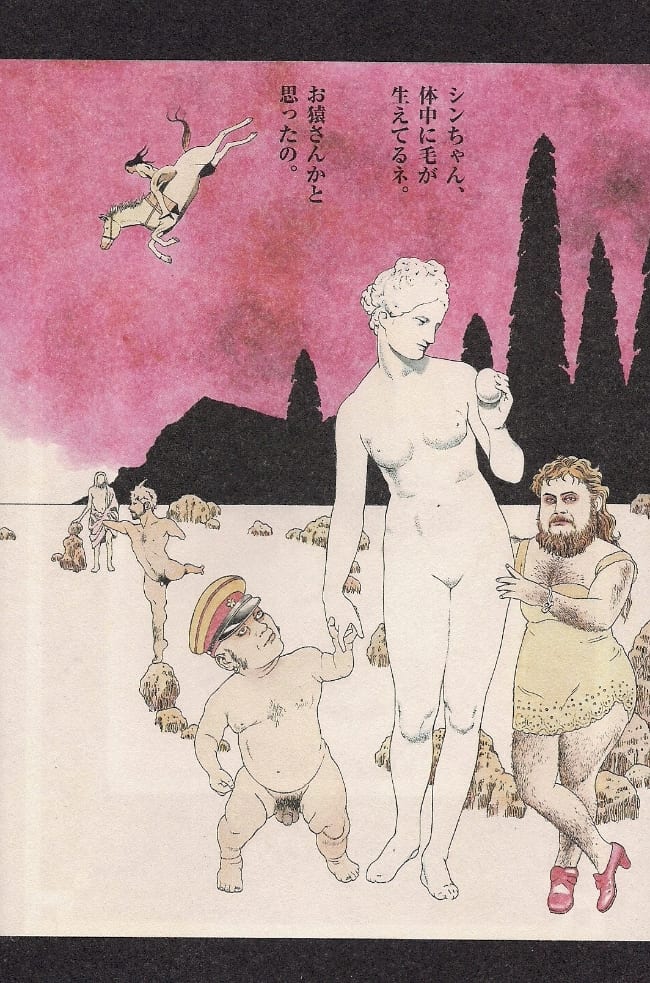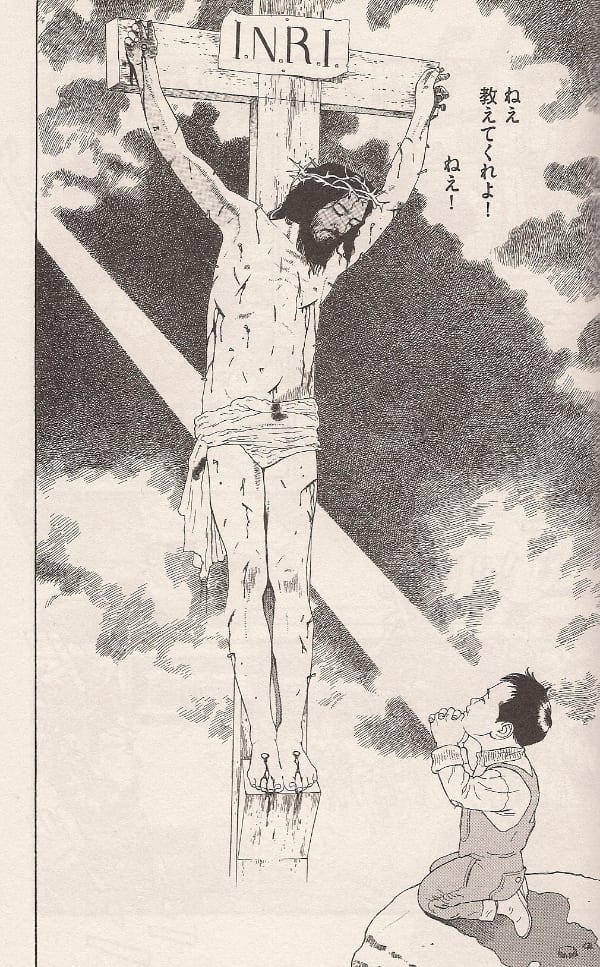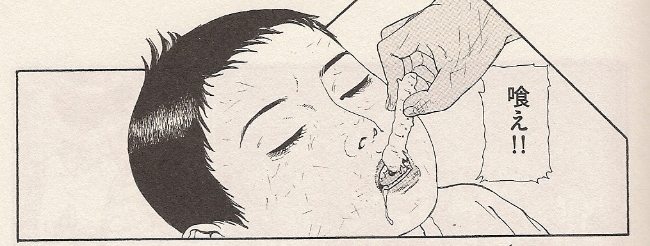Would you be shocked if I told you this is as explicit as the new Suehiro Maruo gets? I mean, damn - he didn't even have to throw a black bar on The D... although the presence of the occasional uncensored erection in Maruo's last book, The Inferno in Bottles, makes me wonder if there isn't some sort of special Suehiro Maruo exception written into Japanese indecency law. He deserves it, though devoted fans have long come around to understanding that he's not the guy from Ultra-Gash Inferno anymore; Maruo is like Cronenberg, in that his later works are absolutely his, redolent of his preoccupations, yet considerably more restrained in terms of explicit content.
I was, of course, still very pleased to import a copy of Maruo's latest: Tomino the Damned, which has been running in Kadokawa's Comic Beam, a seinen monthly known for showcasing unique styles of drawing. It's actually only vol. 1 of an ongoing series, making this Maruo's first multi-book works since The Laughing Vampire over a decade ago. It also hearkens back to one of the artist's earliest longform comics: 1984's Shōjo Tsubaki, aka Midori, aka Mr. Arashi's Amazing Freak Show. Again, we find ourselves in the early Shōwa period, and again we have an innocent girl (and now her twin brother!) abandoned to the care of a lowdown circus populated by Japanese society's rejects: oddities; foreigners; the maimed; the forgotten.
It's all a fine excuse for Maruo to draw the '30s stuff he loves, from glamorous movie stars to old-timey city scenes to innumerable detailed costumes, occasionally deviating into a flashback that reveals the background of a member of the troupe. The build is quite slow - by the time the cliffhanger ending rolls around, it feels like Maruo's just getting started, and maybe he is. A quick glance at the time period and the approximate ages of the protagonist siblings perhaps suggests where this is all going... provided that tragedy is generally the destination with this particular author!
But might we still gesture toward the divine?
The Inferno in Bottles was a short story collection, its title borrowed from Yumeno Kyūsaku's 1928 story of profound sexual angst between shipwrecked siblings on a tropical island, with nothing but a bible to teach them of the world. Maruo's adaptation is immediately followed by a more humorous story of a holy man facing all manner of anti-clerical affronts and temptations. Tomino the Damned, as its title might suggest, also runs with images of sin and guilt and Christ, perhaps as the perfection of Maruo's beloved themes of incandescent suffering and societal rot. Early on, bullies force one of the twins to his knees, feeding him a worm which he receives upon his tongue,in the manner of sacramental bread:
Yet because there is no good news to deliver, this communion merely acclimates the child to his lack of value at the bottom of the social order, his desire for more nourishment, more worms -- more comfort -- climaxing in a rather funny evocation of classic Catholic horror: bug-spewing demonic possession.
Know too that the twins have been stained from birth: she with a discoloration on her left side, and he with a mark on his right, as if they were split apart in the womb, never to heal. More pertinently, however, they were abandoned by their mother, and this is itself a brand of shame. They will always be disadvantaged, placing them in parity with a girl with eight legs, or a boy with one, or hairy infant - born into a fallen world. Still, Maruo tends to stand in solidarity with the omniscience of sin; a foreign concept as useful metaphor. Eventually, everybody will understand how they are complicit...
***
PLEASE NOTE: What follows is not a series of capsule reviews but an annotated selection of items listed by Diamond Comic Distributors for release to comic book retailers in North America on the particular Wednesday identified in the column title above. Be aware that some of these comics may be published by Fantagraphics Books, the entity which also administers the posting of this column. Not every listed item will necessarily arrive at every comic book retailer, in that some items may be delayed and ordered quantities will vary. I have in all likelihood not read any of the comics listed below, in that they are not yet released as of the writing of this column, nor will I necessarily read or purchase every item identified; THIS WEEK IN COMICS! reflects only what I find to be potentially interesting.
***
SPOTLIGHT PICKS!
Michael Jordan: Bull on Parade: Being the new graphic novel from Wilfred Santiago, a 200-page color account of the life of maybe the greatest U.S. sports celebrity of the final quarter of the 20th century. The sample images from this look especially harsh and nervy - just surging with energy. A 5.75" x 7.5" Fantagraphics hardcover. Preview; $24.99.
Henshin: Another source for unique drawing in the manga mainstream was Shogakukan's IKKI, which closed up a few months ago. That was the home of Taiyō Matsumoto's Sunny and Q Hayashida's Dorohedoro, although the magazine was also known for occasionally publishing work by cartoonists active on the international scene, like Felipe Smith's Peepo Choo. Similarly, toward the end of its run, IKKI began posting short comics by Ken Niimura (of the much-admired Image series I Kill Giants) on its website, ultimately putting together a collected book in 2014. Now the cycle swings back around as Image presents an English edition of that material, thirteen stories of everyday sentiment across 288 pages, presented in right-to-left format. And you didn't even have to wait for VIZ! Sample story; $19.99.
--
PLUS!
Sam Zabel and the Magic Pen: Ooh, a 228-page color compilation of webcomics by Dylan Horrocks, which actually originated as a backup feature in the artist's old Drawn & Quarterly series Atlas... which I think was also the last time he published a full-length book of new solo comics. But D&Q brought his signature graphic novel Hicksville back into print a few years ago, and New Zealand's Victoria University Press released a short story compilation (Incomplete Works) just last March, so the time is right for this tale of a cartoonist who can't get anything drawn, only to be dragged inside a weird imaginary history of international comic book fantasy. Note that this is Fantagraphics' North American edition; Knockabout will be publishing the book in the UK, and Victoria University Press in NZ. Preview; $29.99.
Stray Bullets Vol. 6: Killers: Coming about eight a half years after the series had left off, this is writer/artist David Lapham's eight-part continuation of his signature crime comic, now a 248-page Image softcover. This is fitting, as Stray Bullets held a position in the mid-to-late-1990s not dissimilar to many Image series now: high-profile creator-run genre stuff prone to sparking irritation in certain quarters for the attention paid to its deviations from corporate expectations. Gary Groth deemed it "proof that the fanboy cognoscenti... are desperate to validate anything that doesn't look like a superhero or movie tie-in as a mature use of the comics medium" in issue #179 of the Journal, and I don't think the language sounds especially archaic in comics commentary today, circumstantial shifts aside.
That said, seeing Stray Bullets active again today highlights the differences in Lapham's approach from many of his younger companions. What I've come to appreciate about these eight new issues is not the swaggering, wisecrack-laden violence -- which is still present in some capacity, repping the post-Pulp Fiction origins of the series by dint of longevity -- but the severe, ultra-direct melodrama of the plotting, pitched at a top-of-the-lungs register that apportions the same emphasis to a wailing teen boy preparing to shoot himself in a smoke-laden bathroom as any number of gangland confrontations. Indeed, Killers is at heart a romance comic, albeit a sour one, obsessed with the ways in which men desire women and girls as augmentations to their sense of worth. That these sneery encounters have a tendency to end in outrageous violence is like a fantasy of reprisal - the 'coolness' of ultra-efficient generic killing standing in the place of God in the annals of sexual shame. In this way, Stray Bullets feels personal, even obsessed in a manner unlike its fellows, which recall cinema just as much, but now the ballooning SF/fantasy franchises that dominate screens. Perhaps I'm just nostaligic. The next series, Sunshine and Roses, is set to begin later this month; $19.99.
My Neighbor Seki Vol. 1: Your ongoing manga series translation debut of the week, this time an episodic seinen comedy by Takuma Morishige about a schoolgirl who can't help but become distracted by the fanciful and absurd time-wasting schemes cooked up by the boy at the desk next to her. Simple, direct jokes - 170 pages from Vertical. It's up to vol. 6 in Japan; $10.95.
BOOM! Box 2014 Mix Tape: One of the more interesting transformations of the past few years is that of BOOM! into something of a publishing headquarters for not only licensed television animation comics a la Adventure Time, but creator-owned work operating in a sympathetic webcomics-informed cute comedy/pathos style. This 8.5" x 11" special presents 48 pages of the stuff, including contributions by Ryan North, Noelle Stevenson, Jake Lawrence and others; $9.99.
Calculus Cat: I do kind of wonder what's going to happen to all of Knockabout's co-publications with Top Shelf now that the latter has been bought out by IDW. Nonetheless, this appears to be a Knockabout solo release, now imported to North America by Diamond, collecting 112 pages of funny animal strips by Hunt Emerson dating back to the late '70s, and including some new work; $17.99.
Star Wars: The Marvel Years Omnibus: Yes, so this is the week where Marvel officially starts banging out new Star Wars stuff, which means a new series fronted by Jason Aaron & John Cassaday with a seven-figure print run and over a dozen variant covers, but hey old-timer - there's also this giant brick of ancient shit, including art by Howard Chaykin, Carmine Infantino, Michael Golden, Al Williamson and others, compiling the first 44 issues and the first Annual in a big hardcover; $125.00.
Jupiter's Legacy #5: Another issue of this Mark Millar/Frank Quitely inter-generational superhero saga has been completed, resulting in its release for purchase by admirers of Mark Millar and/or Frank Quitely; $4.99.
Wonder Woman: Bondage and Feminism in the Marston/Peter Comics, 1941-48: Finally, your book-on-comics of the week, as Rutgers University Press offers a 264-page study by Journal contributor and Hooded Utilitarian proprietor Noah Berlatsky on "a comic that was radically ahead of its time in terms of its bold presentation of female power and sexuality." This is the softcover edition, though hardcover and digital iterations are also available; $26.95.














